HND Business Management: Marketing Process & Planning at Iceland Foods
VerifiedAdded on 2023/06/04
|20
|4842
|90
Report
AI Summary
This report provides an analysis of the marketing process and planning, focusing on Iceland Foods as a case study. It defines marketing in the 21st century and describes the role of marketing functions within organizations, including brand reputation management, campaign execution, internal communications, and market research. The report also analyzes the interaction of marketing with other departments like finance, production, and human resources. It explains the extended marketing mix (7Ps) with examples from Iceland Foods and Farmfoods, evaluating how the marketing mix contributes to Iceland Foods' success in meeting its business objectives. The report concludes with recommendations for Iceland Foods, such as implementing price skimming and differentiation strategies, offering coupons for bulk buying, and focusing on niche markets. Desklib offers solved assignments.
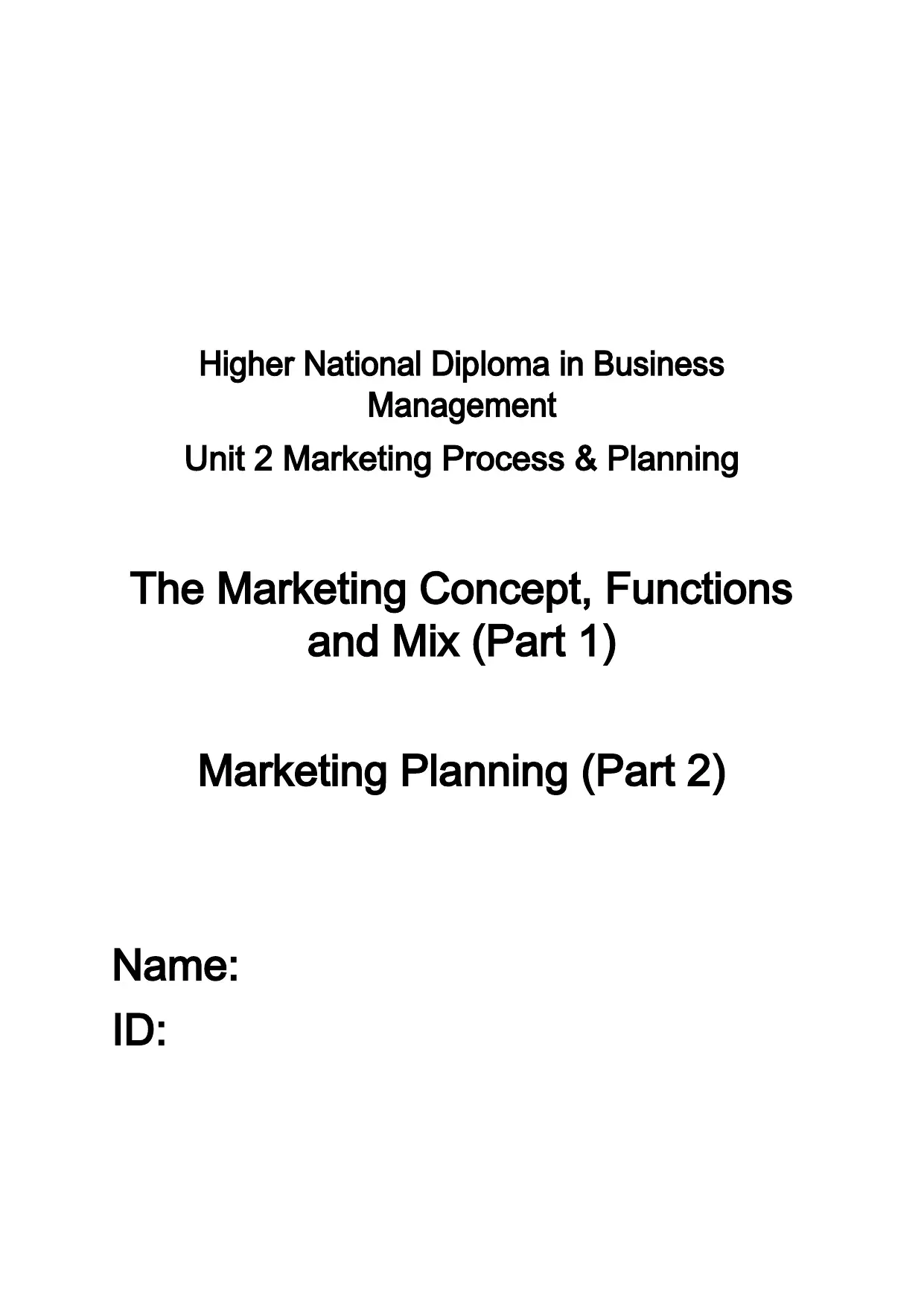
Higher National Diploma in Business
Management
Unit 2 Marketing Process & Planning
The Marketing Concept, Functions
and Mix (Part 1)
Marketing Planning (Part 2)
Name:
ID:
Management
Unit 2 Marketing Process & Planning
The Marketing Concept, Functions
and Mix (Part 1)
Marketing Planning (Part 2)
Name:
ID:
Paraphrase This Document
Need a fresh take? Get an instant paraphrase of this document with our AI Paraphraser
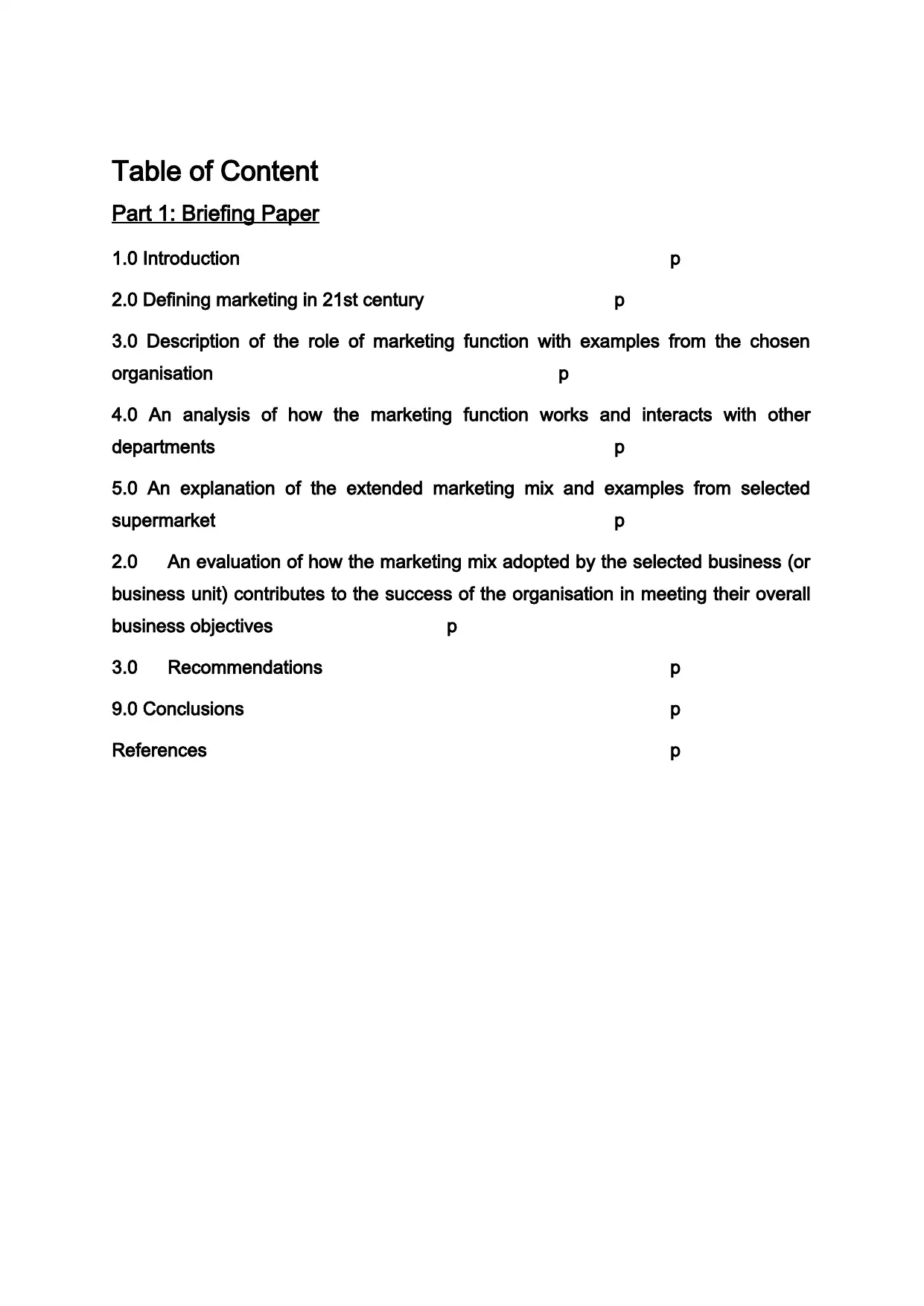
Table of Content
Part 1: Briefing Paper
1.0 Introduction p
2.0 Defining marketing in 21st century p
3.0 Description of the role of marketing function with examples from the chosen
organisation p
4.0 An analysis of how the marketing function works and interacts with other
departments p
5.0 An explanation of the extended marketing mix and examples from selected
supermarket p
2.0 An evaluation of how the marketing mix adopted by the selected business (or
business unit) contributes to the success of the organisation in meeting their overall
business objectives p
3.0 Recommendations p
9.0 Conclusions p
References p
Part 1: Briefing Paper
1.0 Introduction p
2.0 Defining marketing in 21st century p
3.0 Description of the role of marketing function with examples from the chosen
organisation p
4.0 An analysis of how the marketing function works and interacts with other
departments p
5.0 An explanation of the extended marketing mix and examples from selected
supermarket p
2.0 An evaluation of how the marketing mix adopted by the selected business (or
business unit) contributes to the success of the organisation in meeting their overall
business objectives p
3.0 Recommendations p
9.0 Conclusions p
References p
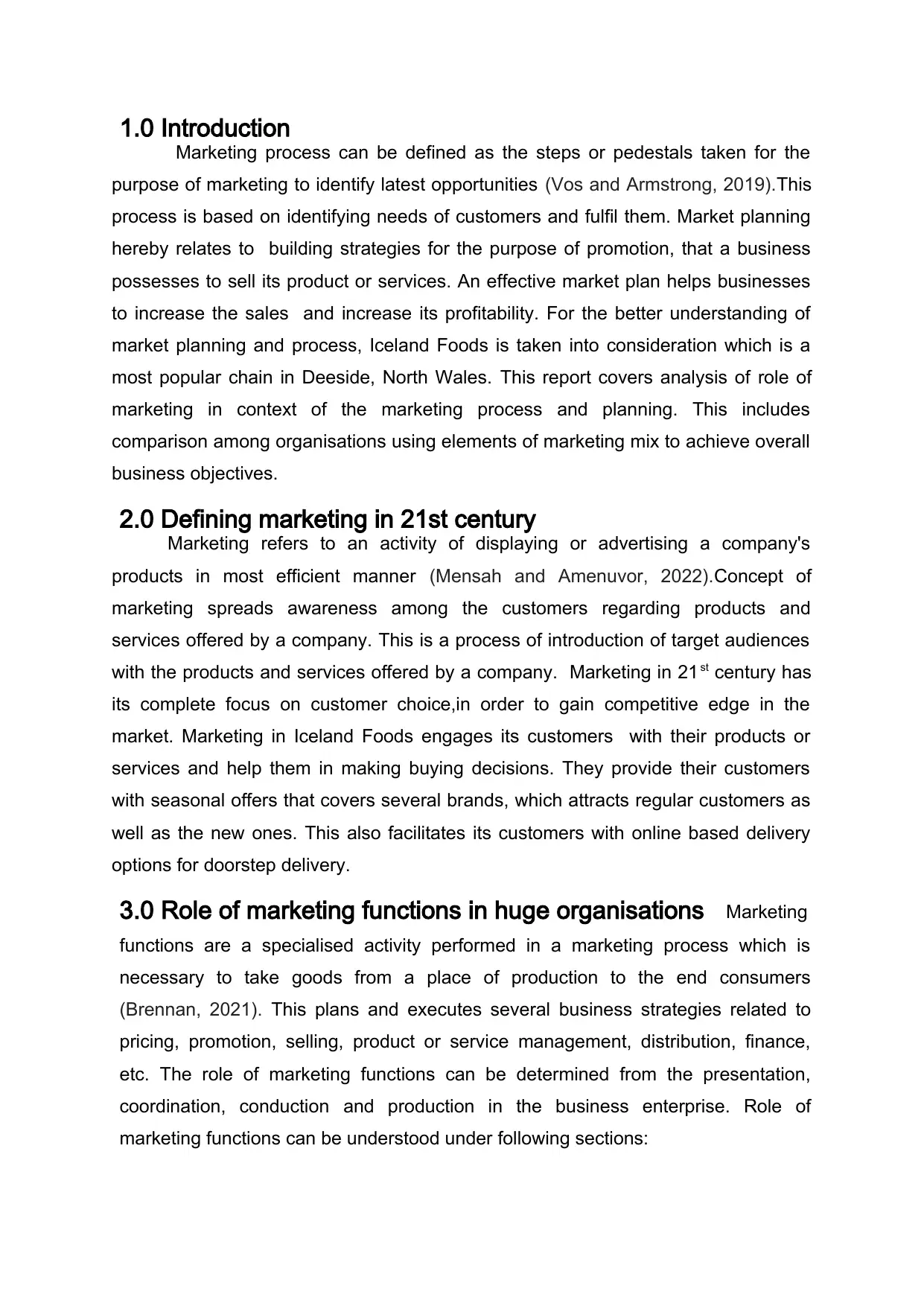
1.0 Introduction
Marketing process can be defined as the steps or pedestals taken for the
purpose of marketing to identify latest opportunities (Vos and Armstrong, 2019).This
process is based on identifying needs of customers and fulfil them. Market planning
hereby relates to building strategies for the purpose of promotion, that a business
possesses to sell its product or services. An effective market plan helps businesses
to increase the sales and increase its profitability. For the better understanding of
market planning and process, Iceland Foods is taken into consideration which is a
most popular chain in Deeside, North Wales. This report covers analysis of role of
marketing in context of the marketing process and planning. This includes
comparison among organisations using elements of marketing mix to achieve overall
business objectives.
2.0 Defining marketing in 21st century
Marketing refers to an activity of displaying or advertising a company's
products in most efficient manner (Mensah and Amenuvor, 2022).Concept of
marketing spreads awareness among the customers regarding products and
services offered by a company. This is a process of introduction of target audiences
with the products and services offered by a company. Marketing in 21 st century has
its complete focus on customer choice,in order to gain competitive edge in the
market. Marketing in Iceland Foods engages its customers with their products or
services and help them in making buying decisions. They provide their customers
with seasonal offers that covers several brands, which attracts regular customers as
well as the new ones. This also facilitates its customers with online based delivery
options for doorstep delivery.
3.0 Role of marketing functions in huge organisations Marketing
functions are a specialised activity performed in a marketing process which is
necessary to take goods from a place of production to the end consumers
(Brennan, 2021). This plans and executes several business strategies related to
pricing, promotion, selling, product or service management, distribution, finance,
etc. The role of marketing functions can be determined from the presentation,
coordination, conduction and production in the business enterprise. Role of
marketing functions can be understood under following sections:
Marketing process can be defined as the steps or pedestals taken for the
purpose of marketing to identify latest opportunities (Vos and Armstrong, 2019).This
process is based on identifying needs of customers and fulfil them. Market planning
hereby relates to building strategies for the purpose of promotion, that a business
possesses to sell its product or services. An effective market plan helps businesses
to increase the sales and increase its profitability. For the better understanding of
market planning and process, Iceland Foods is taken into consideration which is a
most popular chain in Deeside, North Wales. This report covers analysis of role of
marketing in context of the marketing process and planning. This includes
comparison among organisations using elements of marketing mix to achieve overall
business objectives.
2.0 Defining marketing in 21st century
Marketing refers to an activity of displaying or advertising a company's
products in most efficient manner (Mensah and Amenuvor, 2022).Concept of
marketing spreads awareness among the customers regarding products and
services offered by a company. This is a process of introduction of target audiences
with the products and services offered by a company. Marketing in 21 st century has
its complete focus on customer choice,in order to gain competitive edge in the
market. Marketing in Iceland Foods engages its customers with their products or
services and help them in making buying decisions. They provide their customers
with seasonal offers that covers several brands, which attracts regular customers as
well as the new ones. This also facilitates its customers with online based delivery
options for doorstep delivery.
3.0 Role of marketing functions in huge organisations Marketing
functions are a specialised activity performed in a marketing process which is
necessary to take goods from a place of production to the end consumers
(Brennan, 2021). This plans and executes several business strategies related to
pricing, promotion, selling, product or service management, distribution, finance,
etc. The role of marketing functions can be determined from the presentation,
coordination, conduction and production in the business enterprise. Role of
marketing functions can be understood under following sections:
⊘ This is a preview!⊘
Do you want full access?
Subscribe today to unlock all pages.

Trusted by 1+ million students worldwide
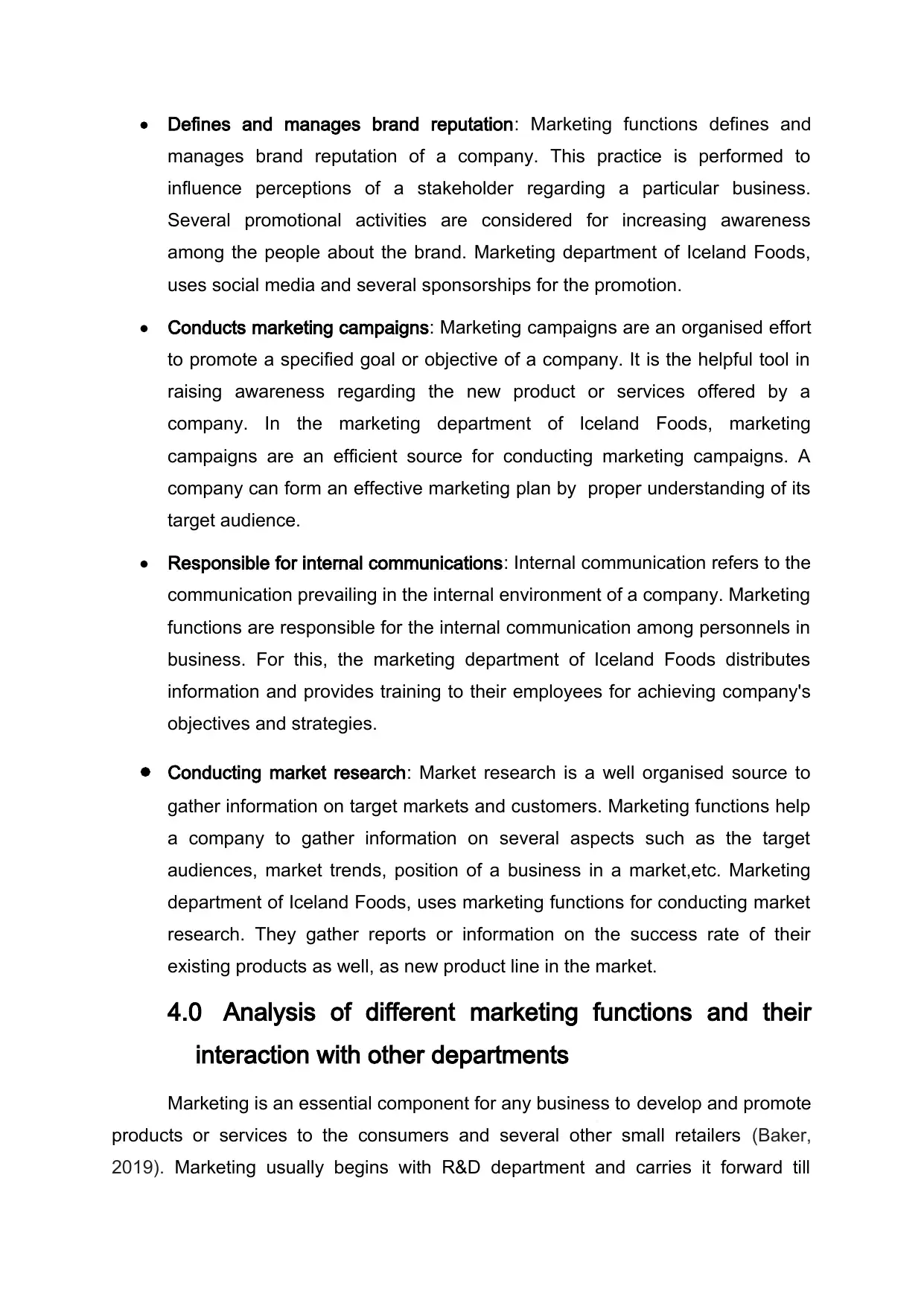
Defines and manages brand reputation: Marketing functions defines and
manages brand reputation of a company. This practice is performed to
influence perceptions of a stakeholder regarding a particular business.
Several promotional activities are considered for increasing awareness
among the people about the brand. Marketing department of Iceland Foods,
uses social media and several sponsorships for the promotion.
Conducts marketing campaigns: Marketing campaigns are an organised effort
to promote a specified goal or objective of a company. It is the helpful tool in
raising awareness regarding the new product or services offered by a
company. In the marketing department of Iceland Foods, marketing
campaigns are an efficient source for conducting marketing campaigns. A
company can form an effective marketing plan by proper understanding of its
target audience.
Responsible for internal communications: Internal communication refers to the
communication prevailing in the internal environment of a company. Marketing
functions are responsible for the internal communication among personnels in
business. For this, the marketing department of Iceland Foods distributes
information and provides training to their employees for achieving company's
objectives and strategies.
Conducting market research: Market research is a well organised source to
gather information on target markets and customers. Marketing functions help
a company to gather information on several aspects such as the target
audiences, market trends, position of a business in a market,etc. Marketing
department of Iceland Foods, uses marketing functions for conducting market
research. They gather reports or information on the success rate of their
existing products as well, as new product line in the market.
4.0 Analysis of different marketing functions and their
interaction with other departments
Marketing is an essential component for any business to develop and promote
products or services to the consumers and several other small retailers (Baker,
2019). Marketing usually begins with R&D department and carries it forward till
manages brand reputation of a company. This practice is performed to
influence perceptions of a stakeholder regarding a particular business.
Several promotional activities are considered for increasing awareness
among the people about the brand. Marketing department of Iceland Foods,
uses social media and several sponsorships for the promotion.
Conducts marketing campaigns: Marketing campaigns are an organised effort
to promote a specified goal or objective of a company. It is the helpful tool in
raising awareness regarding the new product or services offered by a
company. In the marketing department of Iceland Foods, marketing
campaigns are an efficient source for conducting marketing campaigns. A
company can form an effective marketing plan by proper understanding of its
target audience.
Responsible for internal communications: Internal communication refers to the
communication prevailing in the internal environment of a company. Marketing
functions are responsible for the internal communication among personnels in
business. For this, the marketing department of Iceland Foods distributes
information and provides training to their employees for achieving company's
objectives and strategies.
Conducting market research: Market research is a well organised source to
gather information on target markets and customers. Marketing functions help
a company to gather information on several aspects such as the target
audiences, market trends, position of a business in a market,etc. Marketing
department of Iceland Foods, uses marketing functions for conducting market
research. They gather reports or information on the success rate of their
existing products as well, as new product line in the market.
4.0 Analysis of different marketing functions and their
interaction with other departments
Marketing is an essential component for any business to develop and promote
products or services to the consumers and several other small retailers (Baker,
2019). Marketing usually begins with R&D department and carries it forward till
Paraphrase This Document
Need a fresh take? Get an instant paraphrase of this document with our AI Paraphraser
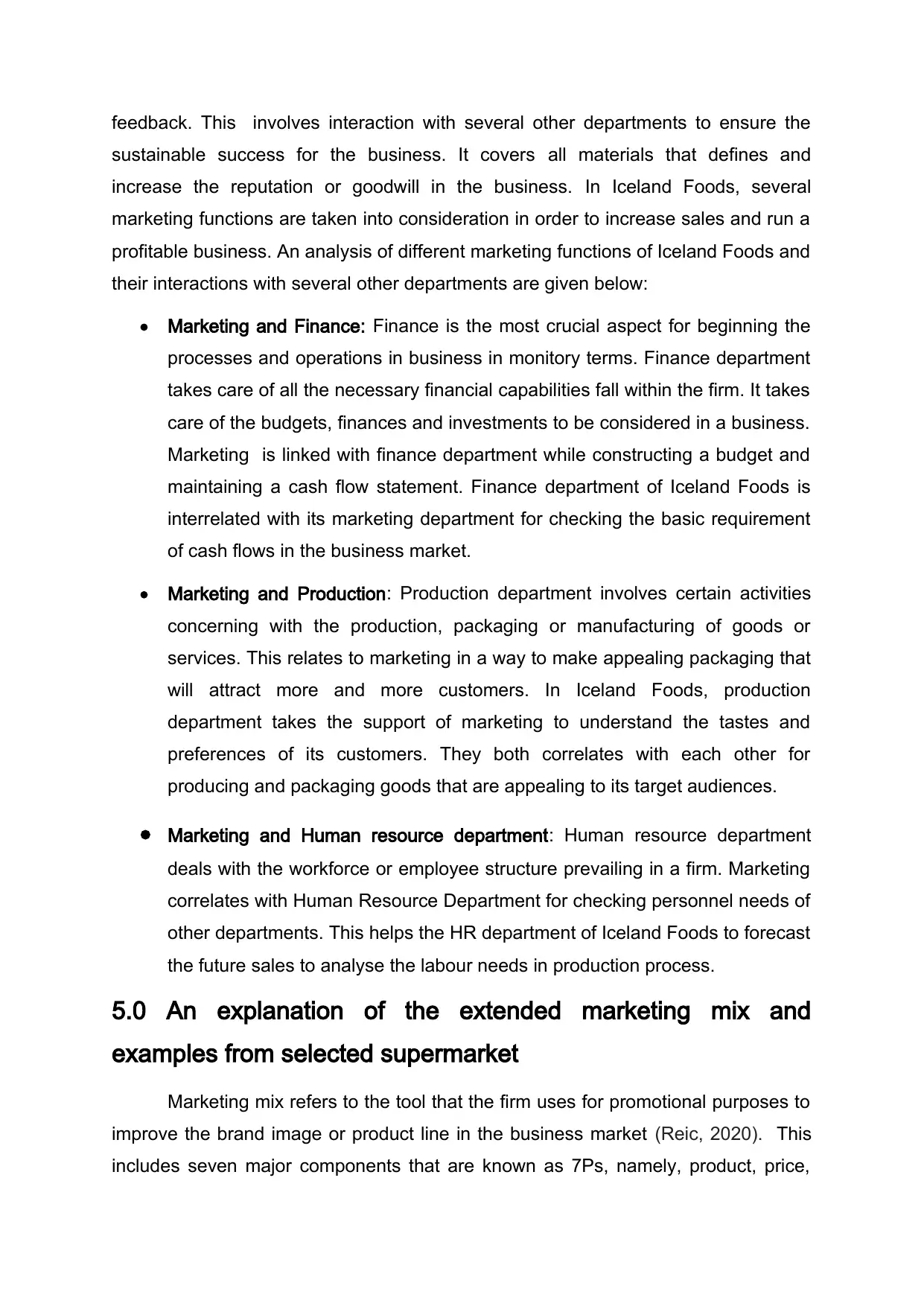
feedback. This involves interaction with several other departments to ensure the
sustainable success for the business. It covers all materials that defines and
increase the reputation or goodwill in the business. In Iceland Foods, several
marketing functions are taken into consideration in order to increase sales and run a
profitable business. An analysis of different marketing functions of Iceland Foods and
their interactions with several other departments are given below:
Marketing and Finance: Finance is the most crucial aspect for beginning the
processes and operations in business in monitory terms. Finance department
takes care of all the necessary financial capabilities fall within the firm. It takes
care of the budgets, finances and investments to be considered in a business.
Marketing is linked with finance department while constructing a budget and
maintaining a cash flow statement. Finance department of Iceland Foods is
interrelated with its marketing department for checking the basic requirement
of cash flows in the business market.
Marketing and Production: Production department involves certain activities
concerning with the production, packaging or manufacturing of goods or
services. This relates to marketing in a way to make appealing packaging that
will attract more and more customers. In Iceland Foods, production
department takes the support of marketing to understand the tastes and
preferences of its customers. They both correlates with each other for
producing and packaging goods that are appealing to its target audiences.
Marketing and Human resource department: Human resource department
deals with the workforce or employee structure prevailing in a firm. Marketing
correlates with Human Resource Department for checking personnel needs of
other departments. This helps the HR department of Iceland Foods to forecast
the future sales to analyse the labour needs in production process.
5.0 An explanation of the extended marketing mix and
examples from selected supermarket
Marketing mix refers to the tool that the firm uses for promotional purposes to
improve the brand image or product line in the business market (Reic, 2020). This
includes seven major components that are known as 7Ps, namely, product, price,
sustainable success for the business. It covers all materials that defines and
increase the reputation or goodwill in the business. In Iceland Foods, several
marketing functions are taken into consideration in order to increase sales and run a
profitable business. An analysis of different marketing functions of Iceland Foods and
their interactions with several other departments are given below:
Marketing and Finance: Finance is the most crucial aspect for beginning the
processes and operations in business in monitory terms. Finance department
takes care of all the necessary financial capabilities fall within the firm. It takes
care of the budgets, finances and investments to be considered in a business.
Marketing is linked with finance department while constructing a budget and
maintaining a cash flow statement. Finance department of Iceland Foods is
interrelated with its marketing department for checking the basic requirement
of cash flows in the business market.
Marketing and Production: Production department involves certain activities
concerning with the production, packaging or manufacturing of goods or
services. This relates to marketing in a way to make appealing packaging that
will attract more and more customers. In Iceland Foods, production
department takes the support of marketing to understand the tastes and
preferences of its customers. They both correlates with each other for
producing and packaging goods that are appealing to its target audiences.
Marketing and Human resource department: Human resource department
deals with the workforce or employee structure prevailing in a firm. Marketing
correlates with Human Resource Department for checking personnel needs of
other departments. This helps the HR department of Iceland Foods to forecast
the future sales to analyse the labour needs in production process.
5.0 An explanation of the extended marketing mix and
examples from selected supermarket
Marketing mix refers to the tool that the firm uses for promotional purposes to
improve the brand image or product line in the business market (Reic, 2020). This
includes seven major components that are known as 7Ps, namely, product, price,
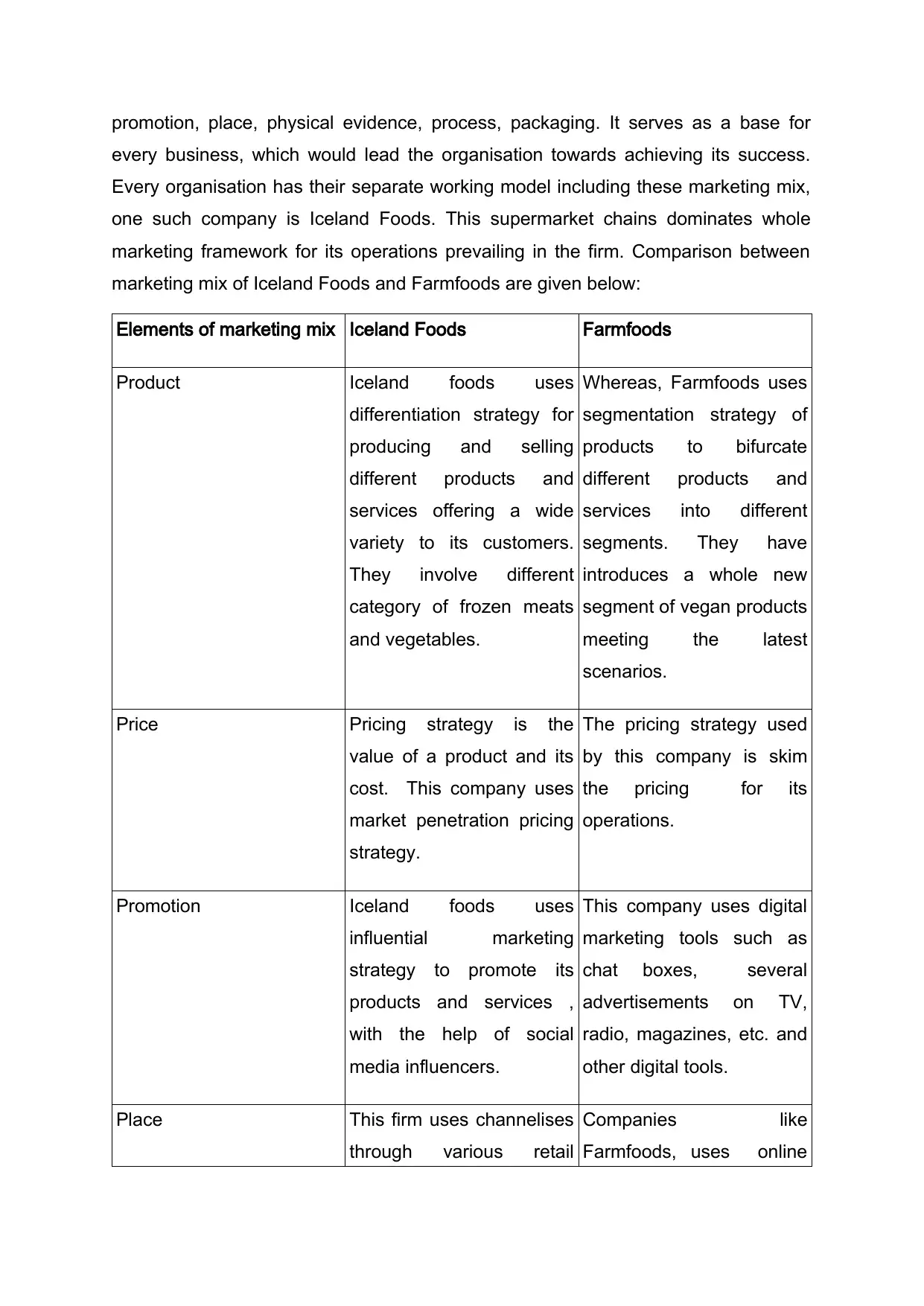
promotion, place, physical evidence, process, packaging. It serves as a base for
every business, which would lead the organisation towards achieving its success.
Every organisation has their separate working model including these marketing mix,
one such company is Iceland Foods. This supermarket chains dominates whole
marketing framework for its operations prevailing in the firm. Comparison between
marketing mix of Iceland Foods and Farmfoods are given below:
Elements of marketing mix Iceland Foods Farmfoods
Product Iceland foods uses
differentiation strategy for
producing and selling
different products and
services offering a wide
variety to its customers.
They involve different
category of frozen meats
and vegetables.
Whereas, Farmfoods uses
segmentation strategy of
products to bifurcate
different products and
services into different
segments. They have
introduces a whole new
segment of vegan products
meeting the latest
scenarios.
Price Pricing strategy is the
value of a product and its
cost. This company uses
market penetration pricing
strategy.
The pricing strategy used
by this company is skim
the pricing for its
operations.
Promotion Iceland foods uses
influential marketing
strategy to promote its
products and services ,
with the help of social
media influencers.
This company uses digital
marketing tools such as
chat boxes, several
advertisements on TV,
radio, magazines, etc. and
other digital tools.
Place This firm uses channelises
through various retail
Companies like
Farmfoods, uses online
every business, which would lead the organisation towards achieving its success.
Every organisation has their separate working model including these marketing mix,
one such company is Iceland Foods. This supermarket chains dominates whole
marketing framework for its operations prevailing in the firm. Comparison between
marketing mix of Iceland Foods and Farmfoods are given below:
Elements of marketing mix Iceland Foods Farmfoods
Product Iceland foods uses
differentiation strategy for
producing and selling
different products and
services offering a wide
variety to its customers.
They involve different
category of frozen meats
and vegetables.
Whereas, Farmfoods uses
segmentation strategy of
products to bifurcate
different products and
services into different
segments. They have
introduces a whole new
segment of vegan products
meeting the latest
scenarios.
Price Pricing strategy is the
value of a product and its
cost. This company uses
market penetration pricing
strategy.
The pricing strategy used
by this company is skim
the pricing for its
operations.
Promotion Iceland foods uses
influential marketing
strategy to promote its
products and services ,
with the help of social
media influencers.
This company uses digital
marketing tools such as
chat boxes, several
advertisements on TV,
radio, magazines, etc. and
other digital tools.
Place This firm uses channelises
through various retail
Companies like
Farmfoods, uses online
⊘ This is a preview!⊘
Do you want full access?
Subscribe today to unlock all pages.

Trusted by 1+ million students worldwide
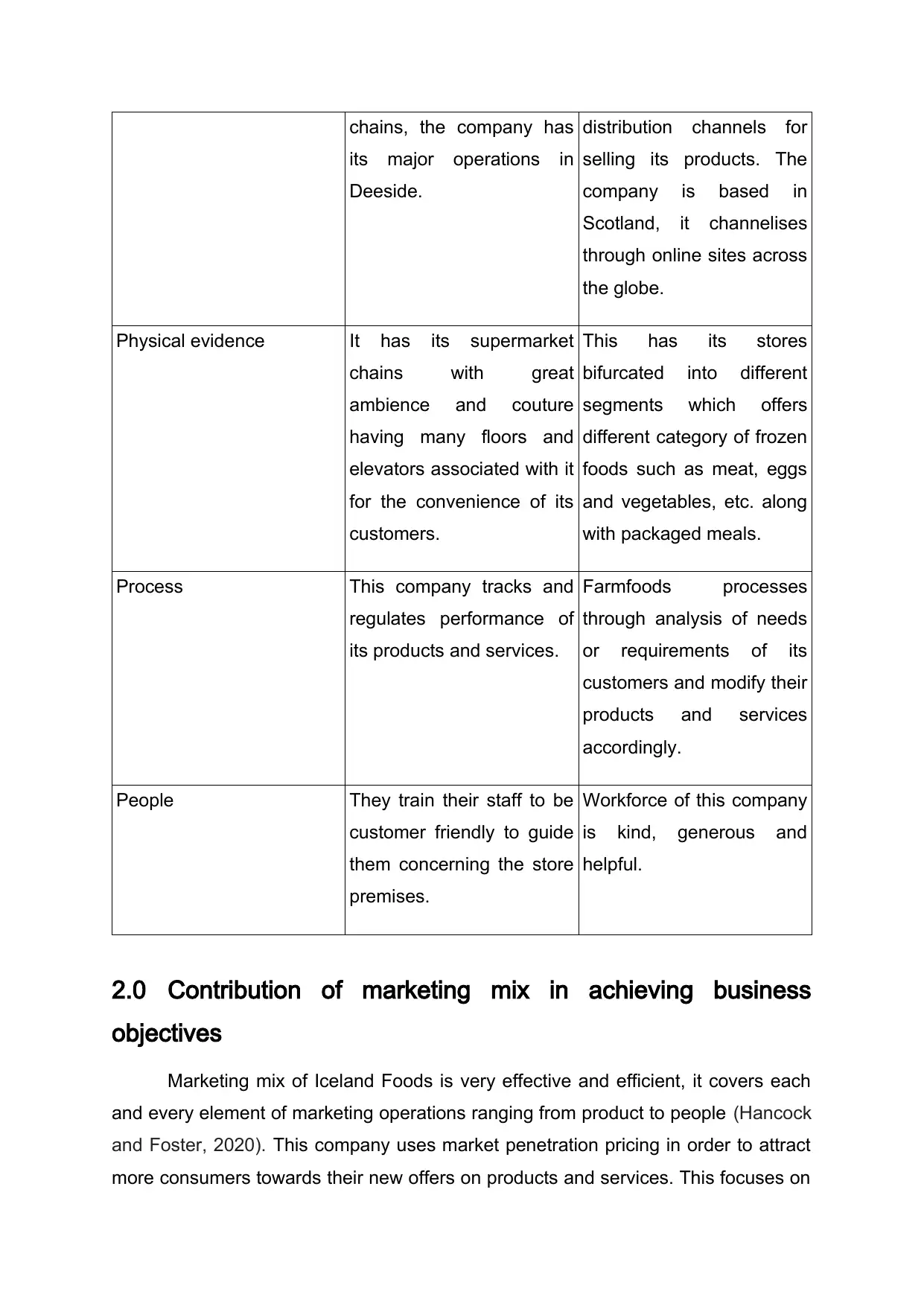
chains, the company has
its major operations in
Deeside.
distribution channels for
selling its products. The
company is based in
Scotland, it channelises
through online sites across
the globe.
Physical evidence It has its supermarket
chains with great
ambience and couture
having many floors and
elevators associated with it
for the convenience of its
customers.
This has its stores
bifurcated into different
segments which offers
different category of frozen
foods such as meat, eggs
and vegetables, etc. along
with packaged meals.
Process This company tracks and
regulates performance of
its products and services.
Farmfoods processes
through analysis of needs
or requirements of its
customers and modify their
products and services
accordingly.
People They train their staff to be
customer friendly to guide
them concerning the store
premises.
Workforce of this company
is kind, generous and
helpful.
2.0 Contribution of marketing mix in achieving business
objectives
Marketing mix of Iceland Foods is very effective and efficient, it covers each
and every element of marketing operations ranging from product to people (Hancock
and Foster, 2020). This company uses market penetration pricing in order to attract
more consumers towards their new offers on products and services. This focuses on
its major operations in
Deeside.
distribution channels for
selling its products. The
company is based in
Scotland, it channelises
through online sites across
the globe.
Physical evidence It has its supermarket
chains with great
ambience and couture
having many floors and
elevators associated with it
for the convenience of its
customers.
This has its stores
bifurcated into different
segments which offers
different category of frozen
foods such as meat, eggs
and vegetables, etc. along
with packaged meals.
Process This company tracks and
regulates performance of
its products and services.
Farmfoods processes
through analysis of needs
or requirements of its
customers and modify their
products and services
accordingly.
People They train their staff to be
customer friendly to guide
them concerning the store
premises.
Workforce of this company
is kind, generous and
helpful.
2.0 Contribution of marketing mix in achieving business
objectives
Marketing mix of Iceland Foods is very effective and efficient, it covers each
and every element of marketing operations ranging from product to people (Hancock
and Foster, 2020). This company uses market penetration pricing in order to attract
more consumers towards their new offers on products and services. This focuses on
Paraphrase This Document
Need a fresh take? Get an instant paraphrase of this document with our AI Paraphraser
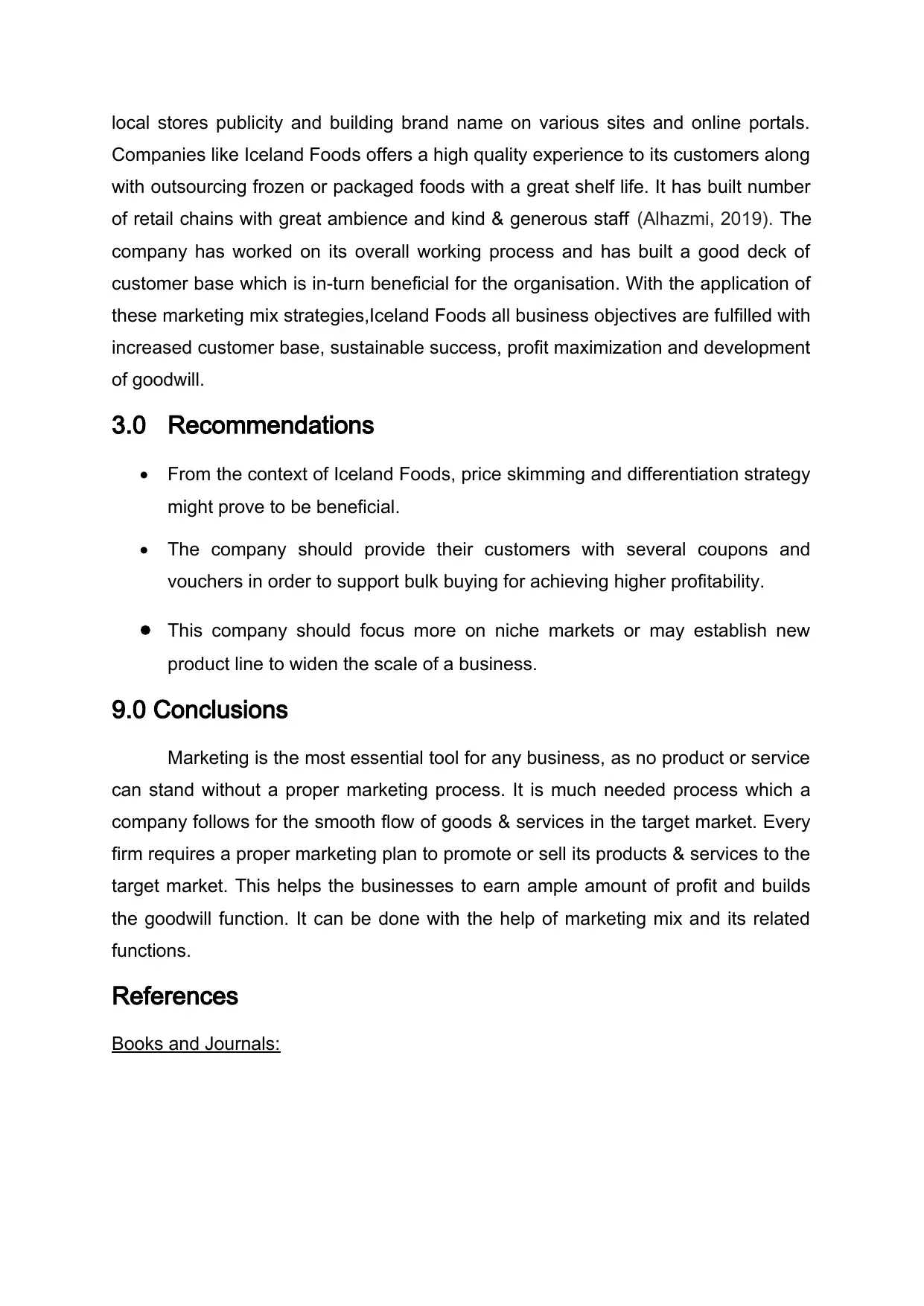
local stores publicity and building brand name on various sites and online portals.
Companies like Iceland Foods offers a high quality experience to its customers along
with outsourcing frozen or packaged foods with a great shelf life. It has built number
of retail chains with great ambience and kind & generous staff (Alhazmi, 2019). The
company has worked on its overall working process and has built a good deck of
customer base which is in-turn beneficial for the organisation. With the application of
these marketing mix strategies,Iceland Foods all business objectives are fulfilled with
increased customer base, sustainable success, profit maximization and development
of goodwill.
3.0 Recommendations
From the context of Iceland Foods, price skimming and differentiation strategy
might prove to be beneficial.
The company should provide their customers with several coupons and
vouchers in order to support bulk buying for achieving higher profitability.
This company should focus more on niche markets or may establish new
product line to widen the scale of a business.
9.0 Conclusions
Marketing is the most essential tool for any business, as no product or service
can stand without a proper marketing process. It is much needed process which a
company follows for the smooth flow of goods & services in the target market. Every
firm requires a proper marketing plan to promote or sell its products & services to the
target market. This helps the businesses to earn ample amount of profit and builds
the goodwill function. It can be done with the help of marketing mix and its related
functions.
References
Books and Journals:
Companies like Iceland Foods offers a high quality experience to its customers along
with outsourcing frozen or packaged foods with a great shelf life. It has built number
of retail chains with great ambience and kind & generous staff (Alhazmi, 2019). The
company has worked on its overall working process and has built a good deck of
customer base which is in-turn beneficial for the organisation. With the application of
these marketing mix strategies,Iceland Foods all business objectives are fulfilled with
increased customer base, sustainable success, profit maximization and development
of goodwill.
3.0 Recommendations
From the context of Iceland Foods, price skimming and differentiation strategy
might prove to be beneficial.
The company should provide their customers with several coupons and
vouchers in order to support bulk buying for achieving higher profitability.
This company should focus more on niche markets or may establish new
product line to widen the scale of a business.
9.0 Conclusions
Marketing is the most essential tool for any business, as no product or service
can stand without a proper marketing process. It is much needed process which a
company follows for the smooth flow of goods & services in the target market. Every
firm requires a proper marketing plan to promote or sell its products & services to the
target market. This helps the businesses to earn ample amount of profit and builds
the goodwill function. It can be done with the help of marketing mix and its related
functions.
References
Books and Journals:
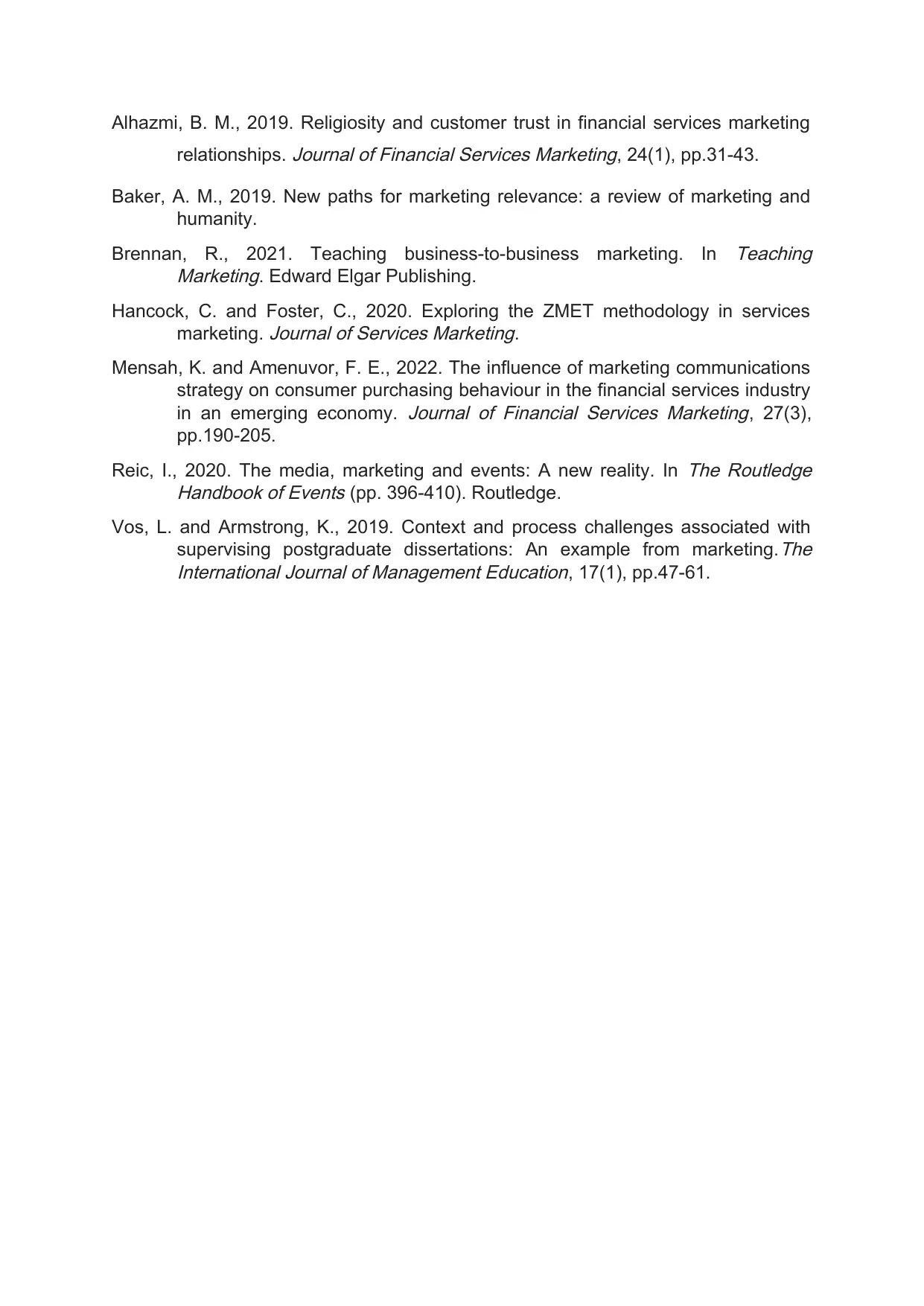
Alhazmi, B. M., 2019. Religiosity and customer trust in financial services marketing
relationships.
Journal of Financial Services Marketing, 24(1), pp.31-43.
Baker, A. M., 2019. New paths for marketing relevance: a review of marketing and
humanity.
Brennan, R., 2021. Teaching business-to-business marketing. In
Teaching
Marketing. Edward Elgar Publishing.
Hancock, C. and Foster, C., 2020. Exploring the ZMET methodology in services
marketing.
Journal of Services Marketing.
Mensah, K. and Amenuvor, F. E., 2022. The influence of marketing communications
strategy on consumer purchasing behaviour in the financial services industry
in an emerging economy.
Journal of Financial Services Marketing, 27(3),
pp.190-205.
Reic, I., 2020. The media, marketing and events: A new reality. In
The Routledge
Handbook of Events (pp. 396-410). Routledge.
Vos, L. and Armstrong, K., 2019. Context and process challenges associated with
supervising postgraduate dissertations: An example from marketing.
The
International Journal of Management Education, 17(1), pp.47-61.
relationships.
Journal of Financial Services Marketing, 24(1), pp.31-43.
Baker, A. M., 2019. New paths for marketing relevance: a review of marketing and
humanity.
Brennan, R., 2021. Teaching business-to-business marketing. In
Teaching
Marketing. Edward Elgar Publishing.
Hancock, C. and Foster, C., 2020. Exploring the ZMET methodology in services
marketing.
Journal of Services Marketing.
Mensah, K. and Amenuvor, F. E., 2022. The influence of marketing communications
strategy on consumer purchasing behaviour in the financial services industry
in an emerging economy.
Journal of Financial Services Marketing, 27(3),
pp.190-205.
Reic, I., 2020. The media, marketing and events: A new reality. In
The Routledge
Handbook of Events (pp. 396-410). Routledge.
Vos, L. and Armstrong, K., 2019. Context and process challenges associated with
supervising postgraduate dissertations: An example from marketing.
The
International Journal of Management Education, 17(1), pp.47-61.
⊘ This is a preview!⊘
Do you want full access?
Subscribe today to unlock all pages.

Trusted by 1+ million students worldwide
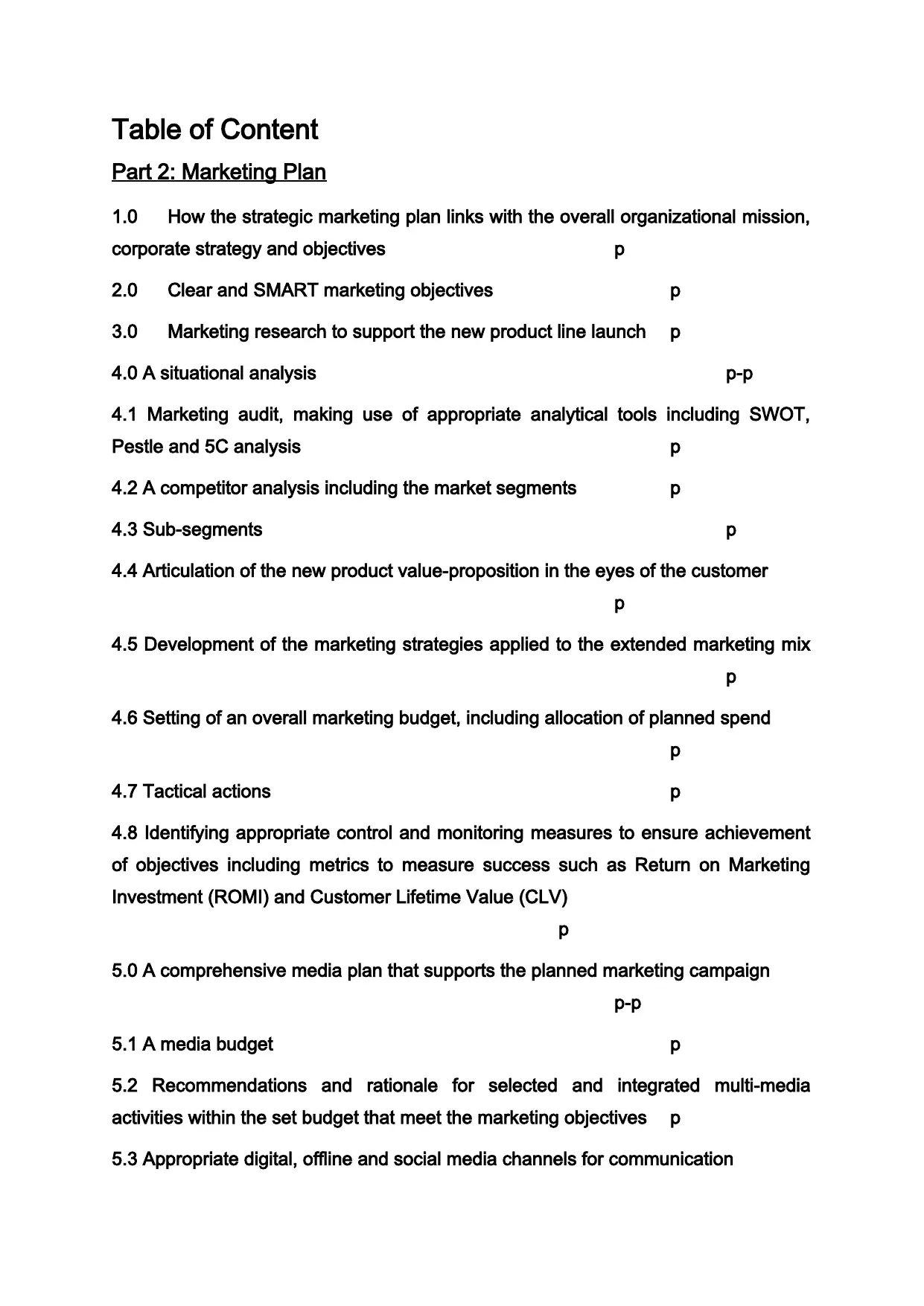
Table of Content
Part 2: Marketing Plan
1.0 How the strategic marketing plan links with the overall organizational mission,
corporate strategy and objectives p
2.0 Clear and SMART marketing objectives p
3.0 Marketing research to support the new product line launch p
4.0 A situational analysis p-p
4.1 Marketing audit, making use of appropriate analytical tools including SWOT,
Pestle and 5C analysis p
4.2 A competitor analysis including the market segments p
4.3 Sub-segments p
4.4 Articulation of the new product value-proposition in the eyes of the customer
p
4.5 Development of the marketing strategies applied to the extended marketing mix
p
4.6 Setting of an overall marketing budget, including allocation of planned spend
p
4.7 Tactical actions p
4.8 Identifying appropriate control and monitoring measures to ensure achievement
of objectives including metrics to measure success such as Return on Marketing
Investment (ROMI) and Customer Lifetime Value (CLV)
p
5.0 A comprehensive media plan that supports the planned marketing campaign
p-p
5.1 A media budget p
5.2 Recommendations and rationale for selected and integrated multi-media
activities within the set budget that meet the marketing objectives p
5.3 Appropriate digital, offline and social media channels for communication
Part 2: Marketing Plan
1.0 How the strategic marketing plan links with the overall organizational mission,
corporate strategy and objectives p
2.0 Clear and SMART marketing objectives p
3.0 Marketing research to support the new product line launch p
4.0 A situational analysis p-p
4.1 Marketing audit, making use of appropriate analytical tools including SWOT,
Pestle and 5C analysis p
4.2 A competitor analysis including the market segments p
4.3 Sub-segments p
4.4 Articulation of the new product value-proposition in the eyes of the customer
p
4.5 Development of the marketing strategies applied to the extended marketing mix
p
4.6 Setting of an overall marketing budget, including allocation of planned spend
p
4.7 Tactical actions p
4.8 Identifying appropriate control and monitoring measures to ensure achievement
of objectives including metrics to measure success such as Return on Marketing
Investment (ROMI) and Customer Lifetime Value (CLV)
p
5.0 A comprehensive media plan that supports the planned marketing campaign
p-p
5.1 A media budget p
5.2 Recommendations and rationale for selected and integrated multi-media
activities within the set budget that meet the marketing objectives p
5.3 Appropriate digital, offline and social media channels for communication
Paraphrase This Document
Need a fresh take? Get an instant paraphrase of this document with our AI Paraphraser
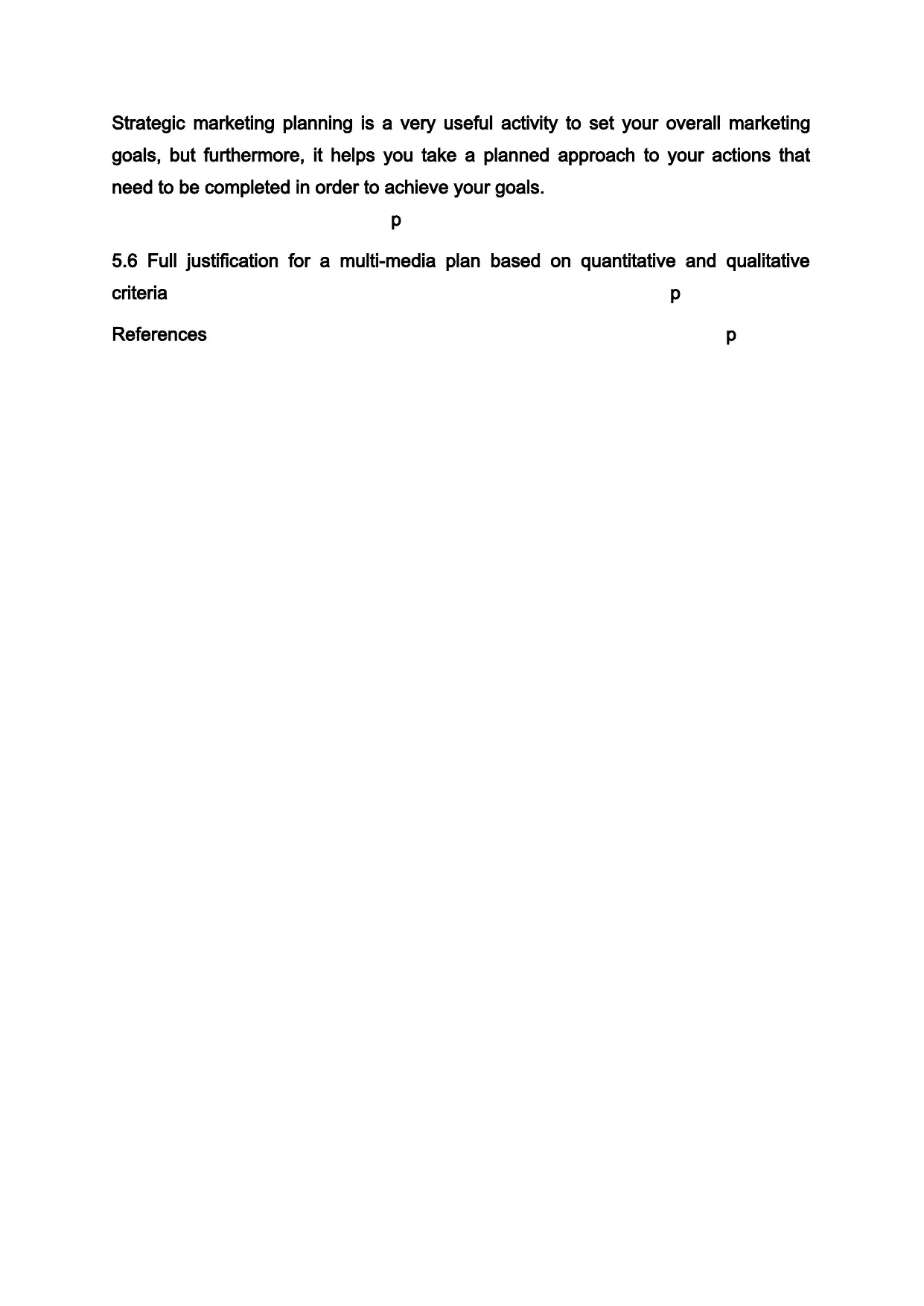
Strategic marketing planning is a very useful activity to set your overall marketing
goals, but furthermore, it helps you take a planned approach to your actions that
need to be completed in order to achieve your goals.
p
5.6 Full justification for a multi-media plan based on quantitative and qualitative
criteria p
References p
goals, but furthermore, it helps you take a planned approach to your actions that
need to be completed in order to achieve your goals.
p
5.6 Full justification for a multi-media plan based on quantitative and qualitative
criteria p
References p
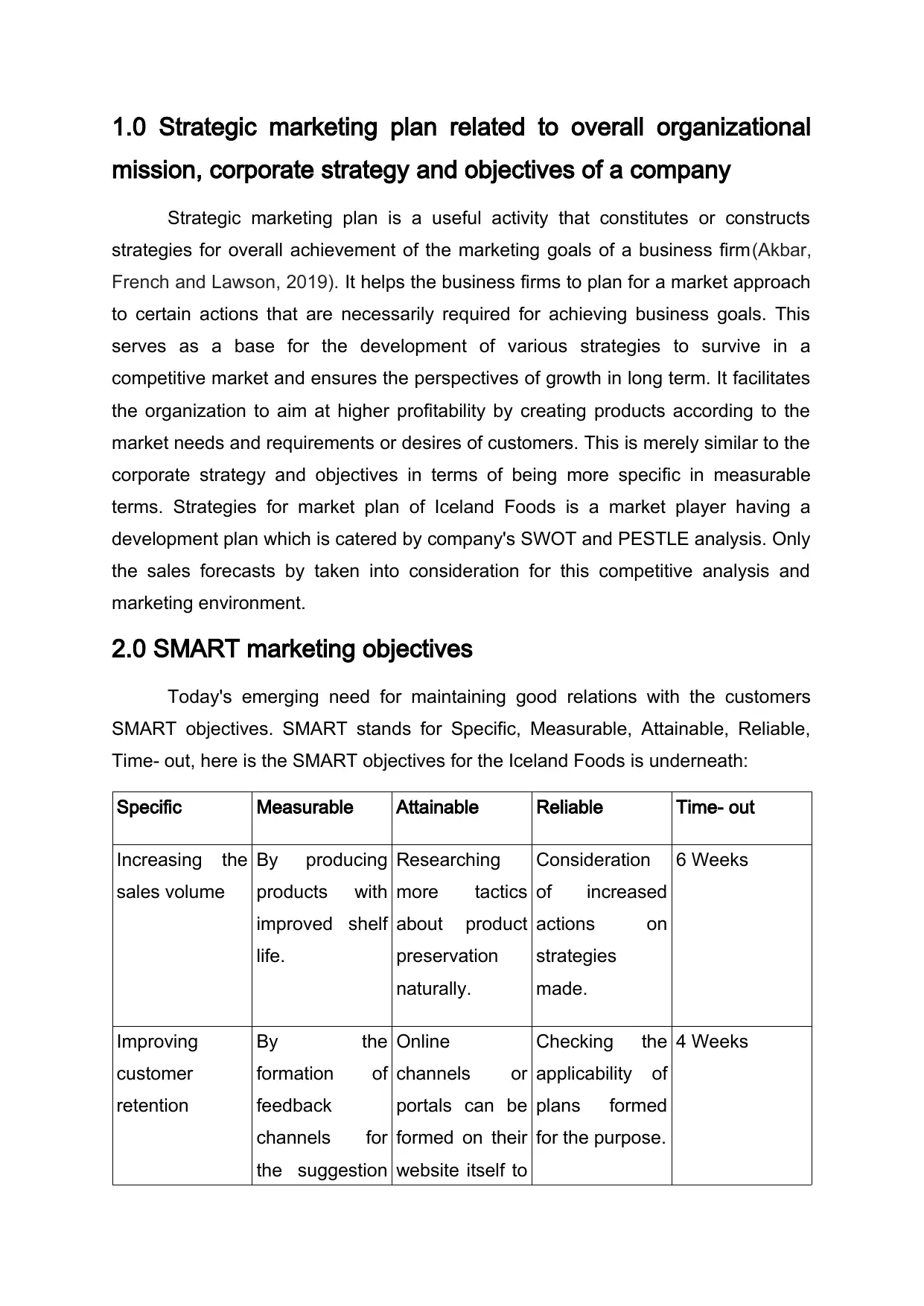
1.0 Strategic marketing plan related to overall organizational
mission, corporate strategy and objectives of a company
Strategic marketing plan is a useful activity that constitutes or constructs
strategies for overall achievement of the marketing goals of a business firm(Akbar,
French and Lawson, 2019). It helps the business firms to plan for a market approach
to certain actions that are necessarily required for achieving business goals. This
serves as a base for the development of various strategies to survive in a
competitive market and ensures the perspectives of growth in long term. It facilitates
the organization to aim at higher profitability by creating products according to the
market needs and requirements or desires of customers. This is merely similar to the
corporate strategy and objectives in terms of being more specific in measurable
terms. Strategies for market plan of Iceland Foods is a market player having a
development plan which is catered by company's SWOT and PESTLE analysis. Only
the sales forecasts by taken into consideration for this competitive analysis and
marketing environment.
2.0 SMART marketing objectives
Today's emerging need for maintaining good relations with the customers
SMART objectives. SMART stands for Specific, Measurable, Attainable, Reliable,
Time- out, here is the SMART objectives for the Iceland Foods is underneath:
Specific Measurable Attainable Reliable Time- out
Increasing the
sales volume
By producing
products with
improved shelf
life.
Researching
more tactics
about product
preservation
naturally.
Consideration
of increased
actions on
strategies
made.
6 Weeks
Improving
customer
retention
By the
formation of
feedback
channels for
the suggestion
Online
channels or
portals can be
formed on their
website itself to
Checking the
applicability of
plans formed
for the purpose.
4 Weeks
mission, corporate strategy and objectives of a company
Strategic marketing plan is a useful activity that constitutes or constructs
strategies for overall achievement of the marketing goals of a business firm(Akbar,
French and Lawson, 2019). It helps the business firms to plan for a market approach
to certain actions that are necessarily required for achieving business goals. This
serves as a base for the development of various strategies to survive in a
competitive market and ensures the perspectives of growth in long term. It facilitates
the organization to aim at higher profitability by creating products according to the
market needs and requirements or desires of customers. This is merely similar to the
corporate strategy and objectives in terms of being more specific in measurable
terms. Strategies for market plan of Iceland Foods is a market player having a
development plan which is catered by company's SWOT and PESTLE analysis. Only
the sales forecasts by taken into consideration for this competitive analysis and
marketing environment.
2.0 SMART marketing objectives
Today's emerging need for maintaining good relations with the customers
SMART objectives. SMART stands for Specific, Measurable, Attainable, Reliable,
Time- out, here is the SMART objectives for the Iceland Foods is underneath:
Specific Measurable Attainable Reliable Time- out
Increasing the
sales volume
By producing
products with
improved shelf
life.
Researching
more tactics
about product
preservation
naturally.
Consideration
of increased
actions on
strategies
made.
6 Weeks
Improving
customer
retention
By the
formation of
feedback
channels for
the suggestion
Online
channels or
portals can be
formed on their
website itself to
Checking the
applicability of
plans formed
for the purpose.
4 Weeks
⊘ This is a preview!⊘
Do you want full access?
Subscribe today to unlock all pages.

Trusted by 1+ million students worldwide
1 out of 20
Related Documents
Your All-in-One AI-Powered Toolkit for Academic Success.
+13062052269
info@desklib.com
Available 24*7 on WhatsApp / Email
![[object Object]](/_next/static/media/star-bottom.7253800d.svg)
Unlock your academic potential
Copyright © 2020–2025 A2Z Services. All Rights Reserved. Developed and managed by ZUCOL.


